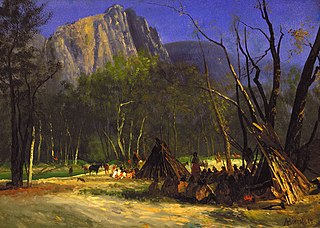 W
WAjax is a 1936–37 painting by the American artist John Steuart Curry. It depicts a well-fed Hereford bull with two cowbirds on his back. The painting is on view at the Smithsonian American Art Museum.
 W
WAlaskan Coast Range is an 1889 landscape painting by Albert Bierstadt that presently hangs in the Smithsonian American Art Museum. While traveling through British Columbia, Bierstadt took a steamship to Alaska in search of more rugged landscapes. He ended up shipwrecked in Loring, Alaska. While sheltering in a nearby Native American settlement, he drew his littoral Alaskan surroundings; this work is most likely an oil sketch made for further detailing.
 W
WAmong the Sierra Nevada, California is an 1868 oil-on-canvas painting by German-American artist Albert Bierstadt which depicts a landscape scene of the Sierra Nevada mountain range in California. Created at his studio in Rome, the painting was exhibited throughout Europe, creating interest in immigration to the United States. Measuring 72 by 120+1⁄8 inches, the painting is a centerpiece of the 19th-century landscape collection at the Smithsonian American Art Museum in Washington, D.C.
 W
WAurora Borealis is an 1865 painting by Frederic Edwin Church of the aurora borealis and the Arctic expedition of Isaac Israel Hayes. The painting measures 142.3 by 212.2 centimetres and is now owned by the Smithsonian American Art Museum.
 W
WComanche Feats of Horsemanship is a 1834-5 Oil on canvas painting by artist George Catlin. It depicts a young man from the Comanche Nation utilizing a war on horseback technique, where he can flexibly drop his body to the side of the horse while riding it, effectively dodging enemies.
 W
WDC Waterfront, Maine Avenue is a painting by Delilah Pierce. It is in the collection of the Smithsonian American Art Museum in Washington, D.C. in the United States.
 W
WElk-Foot of the Taos Tribe is a 1909 painting which is considered to be the masterwork of E. Irving Couse.
 W
WFired On is a 1907 oil painting by Frederic Remington. It measures 68.8 cm × 101.6 cm and has been held by the Smithsonian American Art Museum since 1910.
 W
WThe Headless Horseman Pursuing Ichabod Crane (1858) is a painting by American artist John Quidor, depicting a scene from Washington Irving's 1820 short story "The Legend of Sleepy Hollow".
 W
WIndians in Council, California is an 1872 oil landscape painting by the Hudson River School artist Albert Bierstadt. The painting was made amidst Bierstadt's Yosemite and Sierra Nevada work, while he was residing in California. He felt Native American life was "rapidly passing away", and it was an artist's duty to "tell...their history".
 W
WInterior with Portraits is an 1865 genre scene painted by American artist Thomas Le Clear (1818–1882), commissioned by Franklin Sidway (1834–1920). It features Sidway's siblings, James and Parnell, posing for a photograph in an artist's studio. The children were painted posthumously based on family daguerreotypes, and the painting has been read as representing the tension between its medium and the emergent medium of photography. Interior with Portraits is currently held by the Smithsonian American Art Museum in Washington, D.C.
 W
WThe Iron Mine, Port Henry, New York is a painting by Homer Dodge Martin in the collection of the Smithsonian American Art Museum and measures 30 1/8 x 50 in..
 W
WLandscape with Rainbow is an oil on canvas painting by the African-American artist Robert S. Duncanson. The Hudson River School landscape painting was completed in 1859, while Duncanson was living in Cincinnati, Ohio. It has been in the collection of the Smithsonian American Art Museum in Washington, D.C. since 1983.
 W
WThe Lord Is My Shepherd is an 1863 oil on wood painting by American artist Eastman Johnson. The painting measures 16 5/8 x 13 1/8 in. and is on display at the Smithsonian American Art Museum.
 W
WStevenson Memorial is a 1903 oil painting by the American artist Abbott Handerson Thayer, intended to commemorate the writer Robert Louis Stevenson. Though Thayer initiated several paintings with the intent of honoring Stevenson, Stevenson Memorial is the only version to survive the artist's revisions.
 W
WThe Subsiding of the Waters of the Deluge is an 1829 painting by English-born American artist Thomas Cole depicting the aftermath of the Great Flood.
 W
WSurrender of a Confederate Soldier is an 1873 painting by Julian Scott in the collection of the Smithsonian American Art Museum. The painting depicts an injured soldier of the Confederate States Army in the American Civil War waiving an improvised flag of surrender. The soldier is accompanied by black man and a woman holding an infant: the black man is presumed to be the soldier's slave, and the woman and infant are presumed to be his wife and child.
 W
WA Visit from the Old Mistress is an 1876 painting by American artist, Winslow Homer. It was one of several works that Homer created during a mid-1870s visit to Virginia, where he had served as a war correspondent during the Civil War. Scholars have noted that the painting's composition is taken from Homer's earlier painting Prisoners from the Front, which depicts a group of captive Confederate soldiers defiantly regarding a Union officer. It, along with Homer's other paintings of black southern life from this period, have been praised as an "invaluable record of an important segment of life in Virginia during the Reconstruction."
 W
WWhite River at Sharon is a 1937 watercolor painting by the American Realist artist Edward Hopper. It was painted in September of 1937 while Hopper and his wife were visiting friends on their farm in Sharon, Vermont.
 W
WYoung Omahaw, War Eagle, Little Missouri, and Pawnees is an 1821 painting by the American portrait artist Charles Bird King (1785–1862), who is best known for his portrayals of significant Native American leaders and tribesmen.